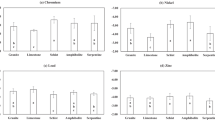Abstract
A sensitivity-resistance index was developed, and proved to be a very sensitive biomonitor of soil pollution with heavy metals. The index was developed by a step-by-step approach. Ultimately, the bacterial soil microflora was divided into three groups, senstivive, tolerant, and resistant microflora. Zn and Cd sensitivity was defined as no growth occurring in the presence of 5 and 0.5 mg l-1 of these metals, respectively, while resistance was defined as distinct growth in the presence of 50 and 16 mg l-1, respectively. The sensitivity: resistance ratio of a referent clay soil (0.57 mg Cd kg-1 and 140 mg Zn kg-1) was 0.53, but for polluted (6 mg Cd kg-1 + 670 mg Zn kg-1) clay soil, the ratio was 0.24. For a referent (0.06 mg Cd kg-1 + 12 mg Zn kg-1) sandy soil the sensitivity: resistance ratio was 1.50 whereas polluted (2.3 mg Cd kg-1 + 252 mg Zn kg-1) sandy soil had a ratio 0.19. The ecological value of the sensitivity-resistance lies in its capacity to reflect potential deradation of aromatic compounds. It has been shown repeatedly that sensitive bacteria grow significantly better on a range of selected aromatic compounds. It has been speculated that resistance fo heavy metals may reduce the bioremediation capacity of soil towards chlorinated aromatics and polyaromatic hydrocarbons.
Similar content being viewed by others
References
Babich H, Stotzky G (1983) Developing standards for environmental toxicants: The need to consider abiotic environmental factors and microbe-mediated ecologic processes. Environ Health Perspect 49:247–260
Brooks PC, McGrath SP (1987) Adenylate energy change in metal contaminated soil. Soil Biol Biochem 19:219–220
Calomiris JJ, Armstrong JL, Seidler RJ (1984) Association of metal tolerance with multiple antibiotic resistance of bacteria isolated from drinking water. Appl Environ Microbiol 47:1238–1242
Doelman P (1985) Resistance of soil microbial communities to heavy metals. In: Jensen V, Kjöller A, Sörensen LH (ed) Microbial communities in soil Elsevier, London New York, pp 369–383
Doelman P, Haanstra L (1979) Effects of lead on the soil bacterial microflora. Soil Biol Biochem 11:487–491
Duxbury T, Bicknell B (1983) Metal-tolerant bacterial populations from natural and metal-polluted soils. Soil Biol Biochem 15:243–250
Foster TJ (1983) Plasmid-determined resistance to antibiotics and toxic heavy metal ions in bacteria. Microbiol Rev 47:361–409
Genstat5 Committee (1987) genstat5 reference manual. Clarendon Press, Oxford
Haanstra L, Oude Voshaar JH, Doelman P (1985) The use of the significant dose response curves in soil ecotoxicological research. Plant and Soil 84:293–297
Kendrick WB (1962) Soil fungi of a copper swamp. Can J Microbiol 8:639–647
Mietz JA, Sjogren RE (1982) Incidence of plasmid-linked antibiotic heavy metal resistant enterics in water-sediment from agricultural and harbour sites. Water Air Soil Pollut 20:147–159
Pochon J, Tardieu P (1962) Technique d'analyse en microbiologie du sol. La Tourelle, St Mandé
Pugh KB, Williams JS (1971) Effect of an organo-mercury fungicide on saprophytic fungi and on litter decomposition. Trans Br Mycol Soc 57:164–166
Ramamoorthy S, Kushner DJ (1975) Binding of mercuric and other heavy metal ions by microbial growth media. Microb Ecol 2:162–171
Reber HH (1992) Simultaneous estimates of the diversity and the degradative capability of heavy-metal-affected soil bacterial communities. Biol Fertil Soils 13:181–186
Rühling A, Tyler G (1973) Heavy metal pollution and decomposition of spruce needle litter. Oikos 24:402–416
Schütt C (1989) Plasmids in bacterial assemblage of a dystrophic lake: Evidence for plasmid-enclosed niche resistance. Microb Ecol 17:49–62
Vishniac W, Santer M (1967) The thiobacilli. Bacteriol Rev 21:195–213
Author information
Authors and Affiliations
Rights and permissions
About this article
Cite this article
Jansen, E., Michels, M., van Til, M. et al. Effects of heavy metals in soil on microbial diversity and activity as shown by the sensitivity-resistance index, an ecologically relevant parameter. Biol Fertil Soils 17, 177–184 (1994). https://doi.org/10.1007/BF00336319
Received:
Issue Date:
DOI: https://doi.org/10.1007/BF00336319




